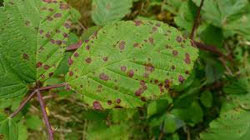Rainy, humid weather in late spring and early summer creates ideal conditions for the development of fungal rust diseases. They often appear on roses, hollyhocks, apple, crabapple and hawthorn. Don’t be surprised if you see rust on clematis as well.
Fungal leaf rusts first appear as yellow or orange pustules on leaf undersides. As the disease progresses, orange or yellow spots appear on the upper leaf surfaces. Spores produced by the fungus are windblown or water-splashed to other leaves. 
Some rust fungi require two different hosts to complete their life cycle, such as juniper hawthorn rust. Others, such as rose or hollyhock rust, complete their life cycle on the same host.
Management strategies include good sanitation, avoiding overhead watering and thinning to increase air circulation in the plant canopy. During the growing season remove affected leaves, stems and canes from roses and hollyhocks as is practical. Removing rust infected leaves from trees is usually not practical, but they can be raked up in the fall.
Avoid overhead watering of infected plants when possible. Dry canopies are less hospitable to rust fungi. Thinning not only dries leaves due to better air circulation, it also allows leaves to photosynthesize more.
Fungicides effective against rusts include triforine, chlorothalanil and bayleton. Timing is critical to control rust, since the fungicides are applied preventively. For example, crabapple, hawthorn and apples should be treated at blossom time, when spores are being dispersed from the juniper host. Rose and hollyhock rusts can be treated as long as new growth is forming and the potential exists for disease spread. Always follow label directions for correct timing and proper use of pesticides.



